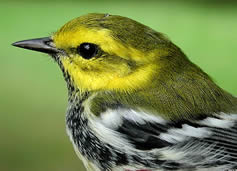| |
|
|
|
|
|
|
|
|
|
|
|
|
|
|
|
|
|
|
|
|
|
|
|
|
|
|
|
|
|
|
|
|
|
|
|
|
|
|
|
|
|
|
|
|
|
|
|
|
|
|
|
|
|
|
|
|
Return
to Biology 1114 Index Page
 |
|
|
|
|
|
|
|
|
|
|
|
|
|
|
|
|
|
|
|
|
|
|
|
|
|
|
|
|
|
|
|
|
|
|
|
|
|
|
|
|
|
|
|
|
|
|
|
|
|
|
|
|
|
|
|
|
|
|
|
|
|
|
|
|
|
|
|
|
|
|
|
|
|
|
|
|
|
|
|
|
|
|
|
|
 source source
|
|
|
|
|
|
|
|
|
|
|
|
|
Fungal
spores are small, spherical, metabolically inactive cells that enable fungi
to survive harsh environ-mental conditions such as cold temperatures and low
humidity. Long, thin flattened cells called hyphae de-velop from fungal spores
when temperature and moisture conditions are suitable for germination (growth).
Both water and warm ambient temperature (25o-27oC) are necessary for spores
to germinate. Water diffuses into the spore to initiate growth
|
|
|
|
|
|
|
|
|
|
|
|
|
|
|
 source source |
|
|
|
|
|
|
|
|
|
|
|
|
|
|
|
|
|
|
|
|
|
|
|
|
|
|
|
|
|
|
|
|
|
|
|
|
|
|
|
|
|
|
|
|
|
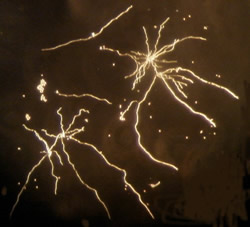 source source |
|
|
|
|
|
|
|
|
|
|
|
|
|
|
|
|
|
|
|
|
|
|
|
|
|
|
|
|
|
|
|
|
|
|
|
|
|
|
|
|
|
|
|
|
|
|
|
|
|
|
|
|
|
|
|
|
|
|
|
|
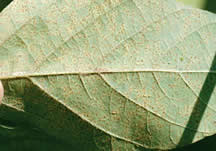 source source |
|
|
|
|
|
|
|
|
|
|
|
|
|
|
|
|
|
|
|
|
|
Fungal
spores of the lethal Asian Soybean Rust were introduced into the southern U.S
from South America by hurricanes. No soybean varieties planted in the U.S. are
resistant to the fungus. Both the fungus and the soybean plant are poikilotherms.
If the fungus becomes firmly established in the southern states where there
is an early planting season, massive numbers of spores could be blown by wind
into the mid-western U.S. This could lead to destruction of most of the American
soybean crop. |
|
|
|
|
|
|
|
|
|
|
|
|
|
|
|
|
|
|
|
|
|
|
|
|
|
|
|
|
|
|
|
|
|
|
|
|
|
|
|
|
|
|
|
|
|
|
|
|
|
|
|
|
|
|
|
|
|
|
|
|
|
|
|
|
|
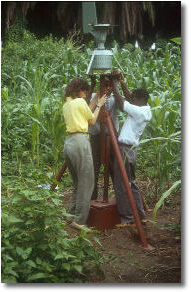 source source |
|
|
|
|
|
|
|
|
|
|
|
|
|
|
|
|
|
|
|
|
|
|
|
|
|
A
team of scientists was interested in the effect of wind speed on the northward
dispersal of the spores from the U.S. Gulf Coast. Using data from sampling stations
throughout the Southeast, the scientists could pinpoint to the day when the
spores had reached a particular sampling station. Weather stations throughout
the region provided data on average wind speed and direction. To test their
hypothesis that the spores dispersed a greater distance northward on strong
versus weak south winds, the scientists plotted southerly wind speed against
distance dispersed for 10 days. After 10 days, the spores had dispersed 96 kilometers
(km) northward. The data look like this: |
|
|
|
|
|
|
|
|
|
|
|
|
|
|
|
|
|
|
|
|
|
|
|
|
|
|
|
|
|
|
|
|
|
|
Day |
Wind
speed (km/h) |
Distance
dispersed (km) |
| 1 |
5 |
2 |
2 |
2 |
0 |
3 |
20 |
18 |
4 |
25 |
22 |
5 |
12 |
10 |
6 |
0 |
0 |
7 |
6 |
3 |
8 |
15 |
12 |
9 |
30 |
28 |
10 |
5 |
1 |
|
|
|
|
|
|
|
|
|
|
|
|
|
|
|
|
|
|
|
|
|
|
|
|
|
|
|
|
|
|
|
|
|
|
|
|
|
|
|
|
|
|
|
|
|
|
|
|
Scientists
predict that rust resistant varieties of soybean plants will not be available
for another 7-8 years. They recommended treating soybean crops with 3 different
but costly fungicides. Fungicides are known to disrupt plasma membranes and
make them leaky to protons (H+). |
|
|
|
|
|
|
|
|
|
|
|
|
|
|
|
|
|
|
|
|
|
|
|
|
|
|
|
|
|
|
|
|
|
|
|
|
|
|
|
|
|
|
|
|
|
|
|
|
|
|
|
|
|
|
|
|
|
|
|
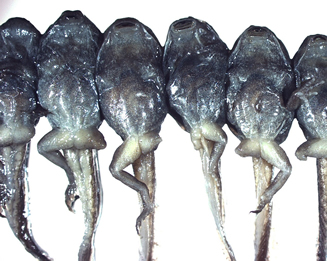 source source |
|
|
|
|
|
|
|
|
|
|
Minnesota
schoolchildren went on a science field trip and discovered that many of the
young frogs they found suffered from deformities such as missing, extra, or
misshapen limbs. They reported their findings to local authorities who verified
these findings, triggering a nationwide expansion of the study. Deformed frogs,
toads, and salamanders were found in 42 states in the U.S. and sites in Canada.
Investigations were initiated to determine the cause. |
|
|
|
|
|
|
|
|
|
|
|
|
|
|
|
|
|
Pieter
Johnson, an undergraduate student at Stanford, conducted one study in California.
He found severe deformities in Pacific tree frogs from 35 surveyed ponds in
California. Johnson decided to focus his inves-tigations on 4 of the 35 ponds.
He questioned whether the deformities were due to pollutants or caused by parasites
of the frogs. The pond waters were tested for pollutants and pesticides; heavy
metals and other pollutants were not detected. While surveying the ponds, a
particular type of snail was found to inhabit all four ponds. Snails can serve
as the first of three hosts used by a parasitic flatworm called a trematode.
Frogs are frequently the second or third host used by these parasitic flatworms
in their cycle of develop-ment and maturation. Johnson decided to dissect some
of the affected frogs and found immature trema-todes (larvae) clustered around
the malformations in the frogs. While the trematodes do cause injury to the
frogs, the frogs do survive, thus this is classified as a parasitic relationship.
To determine whether trematodes caused the deformities, he then collected frog
eggs from ponds that did not contain deformed frogs and later exposed the tadpoles
that hatched to various concentrations of trematode larvae collected from snails
from the four ponds of his study site. One group of tadpoles was not exposed
to the trematode larvae. He found no trematodes or deformities in the unexposed
group of tadpoles, a high incidence of de-formities associated with the presence
of trematodes in the exposed tadpoles, and a higher number of de-formities with
increasing concentrations of larvae. Johnson’s work was published in the
journal, Science. |
|
|
|
|
|
|
|
|
|
|
|
|
|
|
|
|
|
|
|
|
|
|
|
|
|
|
|
|
|
|
|
|
|
|
|
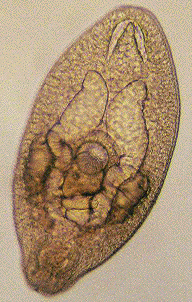 source source |
|
|
|
|
|
|
|
|
|
|
|
|
|
|
|
|
|
|
|
|
|
|
|
|
 source source |
|
|
|
|
|
|
|
|
|
|
|
|
|
|
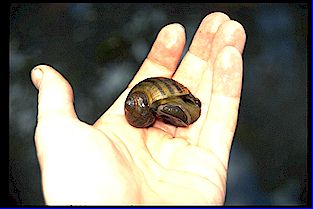 source source |
|
|
|
|
|
|
|
|
|
|
|
|
|
|
|
|
|
|
|
|
|
|
|
|
|
|
|
|
|
|
|
|
|
|
|
|
|
|
|
|
 source source |
|
|
|
|
|
|
|
|
|
|
|
|
|
|
|
|
In
just a few weeks, millions of migratory songbirds will begin to experience physiological
and behavioral changes that will prepare them for the northward spring migration
from wintering areas in Central America and the Caribbean to breeding areas
in the U.S. and Canada. Among other changes, they will increase the rate at
which they feed so that they can accumulate fat to fuel their journey. |
|
|
|
|
|
|
|
|
|
|
|
|
|
|
|
|
|
|
|
|
|
 source source |
|
|
|
|
|
|
|
|
|
|
|
|
|
|
|
|
|
|
|
|
|
|
|
|
|
|
|
|
|
|
The
most difficult part of the journey northward is the non-stop flight across the
Gulf of Mexico from the Yucatan Peninsula to the U.S. Gulf Coast. Small songbirds
(e.g. 9g Black-throated Green Warbler or 14g Worm-eating Warbler) take off from
the Yucatan in the early evening and fly through the night and next morning
to finally make landfall sometime in the afternoon. During the roughly 18-hour
flight in which they beat their wings several times a second to stay aloft,
the birds cannot eat, drink, or land. Songbirds build up a lot of heat while
flapping their wings so rapidly during migration. Birds cannot sweat; a flying
bird cools itself through breathing. |
|
|
|
|
|
|
|
|
|
|
|
|
|
|
|
|
|
|
|
|
|
|
|
|
|
|
|
|
|
|
|
|
|
|
|
|
|
|
|
|
|
|
|
|
|
|
|
|
|
|
|
|
|
|
|
|
|
|
|
|
|
|
|
|
|
|
|
|
|
|
|
|
|
|
|
|
|
|
|
|
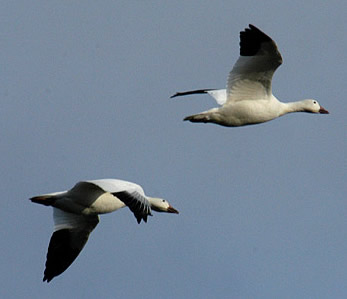 source source |
|
|
|
|
|
|
|
|
|
|
|
|
|
|
|
|
|
|
|
|
|
Some
migrating birds, especially large species like geese and pelicans, fly at altitudes
much higher than they need to in order to avoid obstacles on the ground. If
birds fly too high, they may reach in altitude at which oxygen is limited and
their respiratory rate falls below their energy demand for flight. |
|
|
|
|
|
|
|
|
|
|
|
|
|
|
|
|
|
|
|
|
|
|
|
|
|
|
|
|
|
|
|
|
|
|
|
|
|
|
|
|
|
A
9,000-kg elephant can get mighty warm by mid-day under the hot sun during the
East African dry season. African elephants cool off by wallowing in water or
mud. When there is no water hole nearby, they cool themselves by fanning their
large ears back and forth |
|
|
|
|
|
|
|
|
|
|
|
|
|
|
|
|
|
|
|
|
|
|
|
|
|
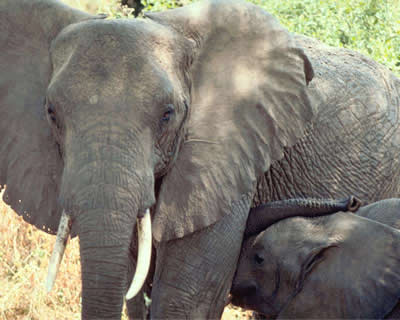 source source |
|
|
|
|
|
|
|
|
|
|
|
|
|
|
|
|
|
|
|
|
|
|
|
|
|
|
|
|
|
|
|
|
|
|
|
|
|
|
|
|
|
|
|
|
|
 source source |
|
|
|
|
|
|
|
|
|
|
|
|
|
|
|
|
|
|
|
|
|
|
|
|
|
|
|
|
|
|
|
|
|
|
|
|
|
|
|
|
|
|
|
|
|
|
|
|
|
|
|
|
|
|
|
|
|
|
|
The
recent concerns over the possible harmful affects of Vioxx, including heart
attacks and strokes, were “based on new, three-year data from a …
randomized, placebo-controlled, clinical trial .” The placebo probably
consisted of a pill similar in shape, size, color, texture, etc. to Vioxx without
the active ingredient, rofecoxib.(http://www.vioxx.com/rofecoxib/vioxx/consumer/index.jsp) |
|
|
|
|
|
|
|
|
|
|
|
|
|
|
|
|
|
|
|
|
|
|
|
|
|
|
|
|
|
|
|
|
|
|
|
|
|
|
|
|
|
|
|
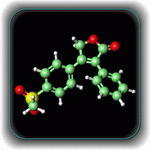 source source |
|
|
|
|
|
|
|
|
|
|
|
|
|
|
|
|
|
|
 source source |
|
|
|
|
|
|
|
|
|
|
|
|
 source source |
|
|
|
|
|
|
 |
 |
 |
 |
 |
 |
 |
 |
 |
 |
 |
 |
 |
 |
 |
 |
 |
 |
 |
 |
 |
 |
 |
 |
 |
 |
 |
 |
 |
 |
 |
 |
 |
 |
 |
 |
 |
 |
 |
 |
 |
 |
 |
 |
 |
 |
 |
 |
 |
 |
 |
 |
 |
 |
 |
 |
 |
 |
 |
 |
 |
 |
 |
 |
 |
 |
 |

 source
source
 source
source source
source source
source source
source source
source source
source source
source source
source source
source source
source source
source source
source source
source source
source source
source source
source
